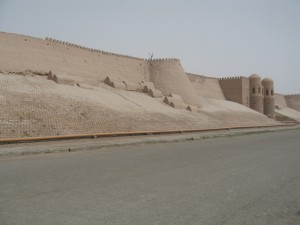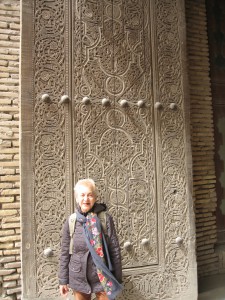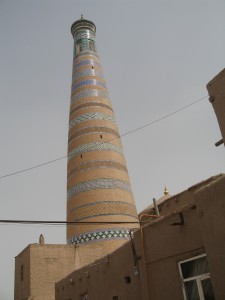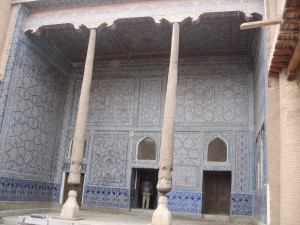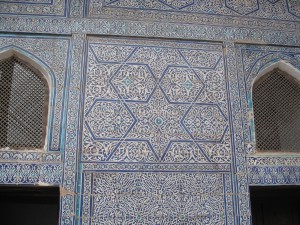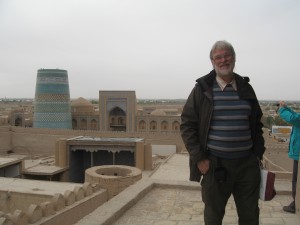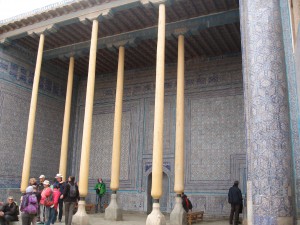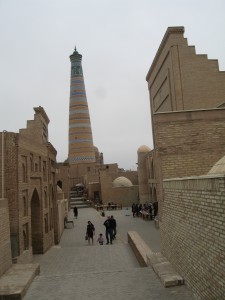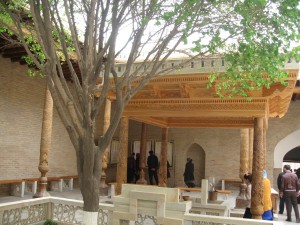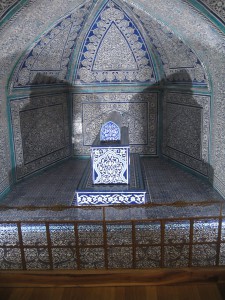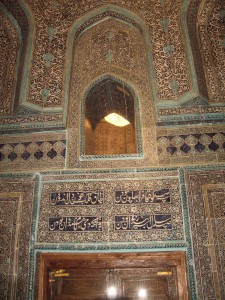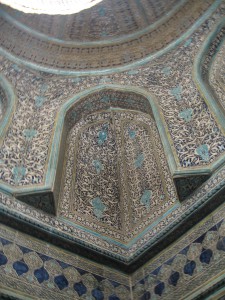Khiva Xiva
Започвам да пиша спомените си от Кива 3 месеца след посещението ни там. Кива се състои от стара и нова част. Новата част на града, където е летището, има различно име и е модерен град. В Кива живеят около 51,000 жители. Разбира се по време на туристическият сезон, те се увеличават значително.
I am starting to write about our visit to Khiva, with a three months delay. The town consists of an old part and a new part. The latter is a modern town with a different name, where the airport is. Khiva has about 51,000 inhabitants, whose number increases drastically in the long tourist season.
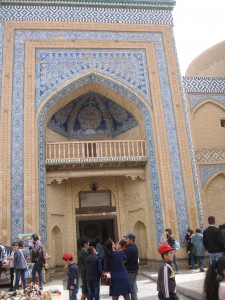 Кива е изключително важна спирка за търговците по Пътя на Коприната, тръгнали от Китай до Европа и обратно. Важността му през това време не може да бъде недооценена. Сега, старият град е Паметник на ЮНЕСКО, и един от брилянтите на Узбекистан, като музей на открито.
Кива е изключително важна спирка за търговците по Пътя на Коприната, тръгнали от Китай до Европа и обратно. Важността му през това време не може да бъде недооценена. Сега, старият град е Паметник на ЮНЕСКО, и един от брилянтите на Узбекистан, като музей на открито.
Khiva is a very important staging post on the silk route from China to Europe and back. Its importance at the time could not be underestimated. Now a UNESCO heritage sight, it is one of the few gems of Uzbekistan, doubling up as an open air museum.
Градът е разположен в югоизточната част на страната, близо до южната им граница. Старата част има удивителен външен вид и неясна история.
Khiva is positioned at the south-eastern border of the country next their southern border. The old part of the town has an amazing view and vague history.
Градът е бившата столица на Ханството Кива. Има няколко легенди за създаването му. Първата е свързана с един от синовете на Ной – Шем. Та след 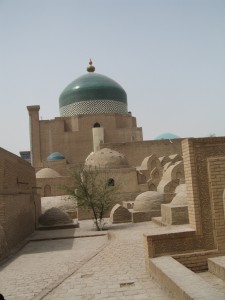 потопа, Шем се отделил от семейството си и се загубил. Тръгнал да ходи из пустинята Кизил Кум с надежда, че ще открие членовете на семейството си, но не успял. Изтощен, с идването на нощта, той заспал и сънувал чуден сън. В съня си, той видял много хора, със 300 запалени факли – но те не били заедно, а били на определени места и с факлите си очертавали кораб.
потопа, Шем се отделил от семейството си и се загубил. Тръгнал да ходи из пустинята Кизил Кум с надежда, че ще открие членовете на семейството си, но не успял. Изтощен, с идването на нощта, той заспал и сънувал чуден сън. В съня си, той видял много хора, със 300 запалени факли – но те не били заедно, а били на определени места и с факлите си очертавали кораб.
За да преживее, Шем започнал да търси вода и не след дълго успял да изкопае кладенец, от който бликала много приятна на вкус, чиста вода. Как се е свързал с или намерил жена си, която фигурира в различни религиозни документи с различни имена, в зависимост от техния произход, не се знае. Легендата гласи, че той е създал град Кива и е наредил да се построят с тухли от кал градските му стени във формата на кораб – този от съня му. Петте му синове и семействата му били първоначалните му граждани.
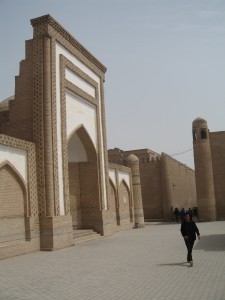 The town was the former capital of the Khiva Khaganate. There are several legends about its creation. The first of those is related to Noah’s son – Shem. So here goes – after the flood, Shem got separated from everyone and got lost. He started walking around the Kyzyk Kum dessert in the hope that he would find members of his family, but alas – he did not. Absolutely exhausted, when the night came, he lied down to sleep and had a miraculous dream. In it, he saw a large number of people with 300 burning torches. But they were not together. They were dispersed in space and their torches outlined the form of a ship!
The town was the former capital of the Khiva Khaganate. There are several legends about its creation. The first of those is related to Noah’s son – Shem. So here goes – after the flood, Shem got separated from everyone and got lost. He started walking around the Kyzyk Kum dessert in the hope that he would find members of his family, but alas – he did not. Absolutely exhausted, when the night came, he lied down to sleep and had a miraculous dream. In it, he saw a large number of people with 300 burning torches. But they were not together. They were dispersed in space and their torches outlined the form of a ship!
In order to survive, Shem started to look for water and after some time, dug a well, from which came out clean and extremely tasty water. How he managed to contact or find his wife, who in sources from different nationalities, figures with different names – we have no idea. The legend insists that he created the town of Khiva and ordered the building of its walls from mud bricks in the shape of a ship – the one from his dream. The families of his five sons were its first citizens.
По малко вълнуващите варианти на произхода на името го свързват с възклицанието „Кей Вах!“ – „Какво удоволствие“ – който всеки, който кусвал 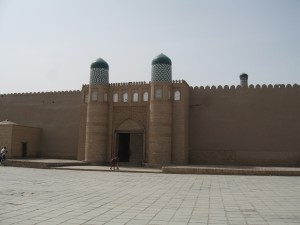 водата на Кива произнасял. В последствие, то се трансформирало в Кива.
водата на Кива произнасял. В последствие, то се трансформирало в Кива.
The less-thrilling variants of the name connect it to the exclamation “hey vach!” – “what pleasure”, which was what everyone who tasted the water of the well said. With time, it was shortened to Khiva.
Други мислят, че името е заето от тюркското име не ханството Киварезем, в последствие съкратено на Кива.
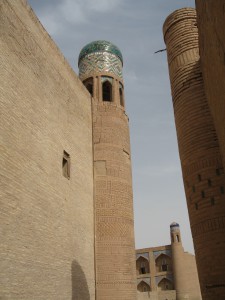 Others suggest that the name could have been derived from the Turkic name of the Khanate Kiwaresem, and then shortened to Khiva.
Others suggest that the name could have been derived from the Turkic name of the Khanate Kiwaresem, and then shortened to Khiva.
Историческите данни сочат, че градът е основан по време на възлизането на християнството, а най-ранните археологически останки намерени там са от 6 век. Първите записки, в които се появяват писмени описания, са от мюсюлмански пътешественици от 10 век. Първоначалното население на града е било от ирански произход. Много и различни нации са владели града през вековете, докато през 17 век, той стават част от ханство Кива, владяно от далечни наследници на Чингиз хан.
Historical data suggests that the town was first settled at the time of the appearance of Christianity. The earliest archaeological remains date form the 6th century. The city appears first in written sources left to us from Muslim travellers from the 10th century. The initial population of the town was from Iranian descent. Many different nations have owned the town and the Khaganate through the centuries. During the 17th century, it became part of the Khaganate of Khiva, which was ruled by distant descendants of Chinghiz Khan.
През 1873 година, Русия завладява Ханството, но то продължава да съществува като отделна държавна единица, като протекторат на Руската империя. След 1917 година, комунистите вземат власт в ханството за кратко време, а през 1924 година то става пълноправна част от Съветския съюз и една от републиките му.
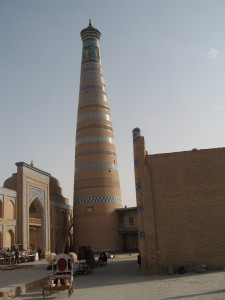 During 1873, The Russian army conquers the Khaganate, but it continues to exist as protectorate of the Russian empire. Soon after the Russian revolution, the communists take over the power in the Khaganate for a short time. In 1924, it became a part of Uzbekistan and a proper republic of the USSR.
During 1873, The Russian army conquers the Khaganate, but it continues to exist as protectorate of the Russian empire. Soon after the Russian revolution, the communists take over the power in the Khaganate for a short time. In 1924, it became a part of Uzbekistan and a proper republic of the USSR.
Сега Узбекистан е част от Aзиатския съюз, покровителстван от Русия.
Now, Uzbekistan is part of the Asian Union, under the patronage of Russia.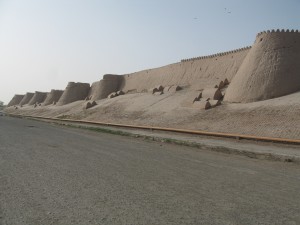
Градът грабва не само с удивителните си стени, замазани с кал и пясък – с четири огромни порти от 12 век, но и с Мавзолеят на Пахлаван Махмуд – боксьор, боец, поет и държавник; с широкото си, нарочно незавършено от строителя минаре; пазарите по улиците и удивителните гледки на сгради на където се обърне човек..
Parts of the appeal are not only the amazing walls form the 12th century with their four large gates, but the Mausoleum of Pahlawan Mahmud – boxer and fighter, poet and statesman, much honoured by the whole population; the big minaret, purposefully unfinished by its builder, the bazars on the streets and the amazing views of beautiful buildings anywhere you turn.
В същност, нещата, които купихме от Кива бяха доста поевтини от тези, купени от Бухара и Самарканд.

The builder of this minaret has been told by the sultan that he would be beheaded, when it is finished , so he left it unfinished and ran!
Our purchases form Khiva, were by far cheaper by the equivalents in Bukhara and Samarkand.
